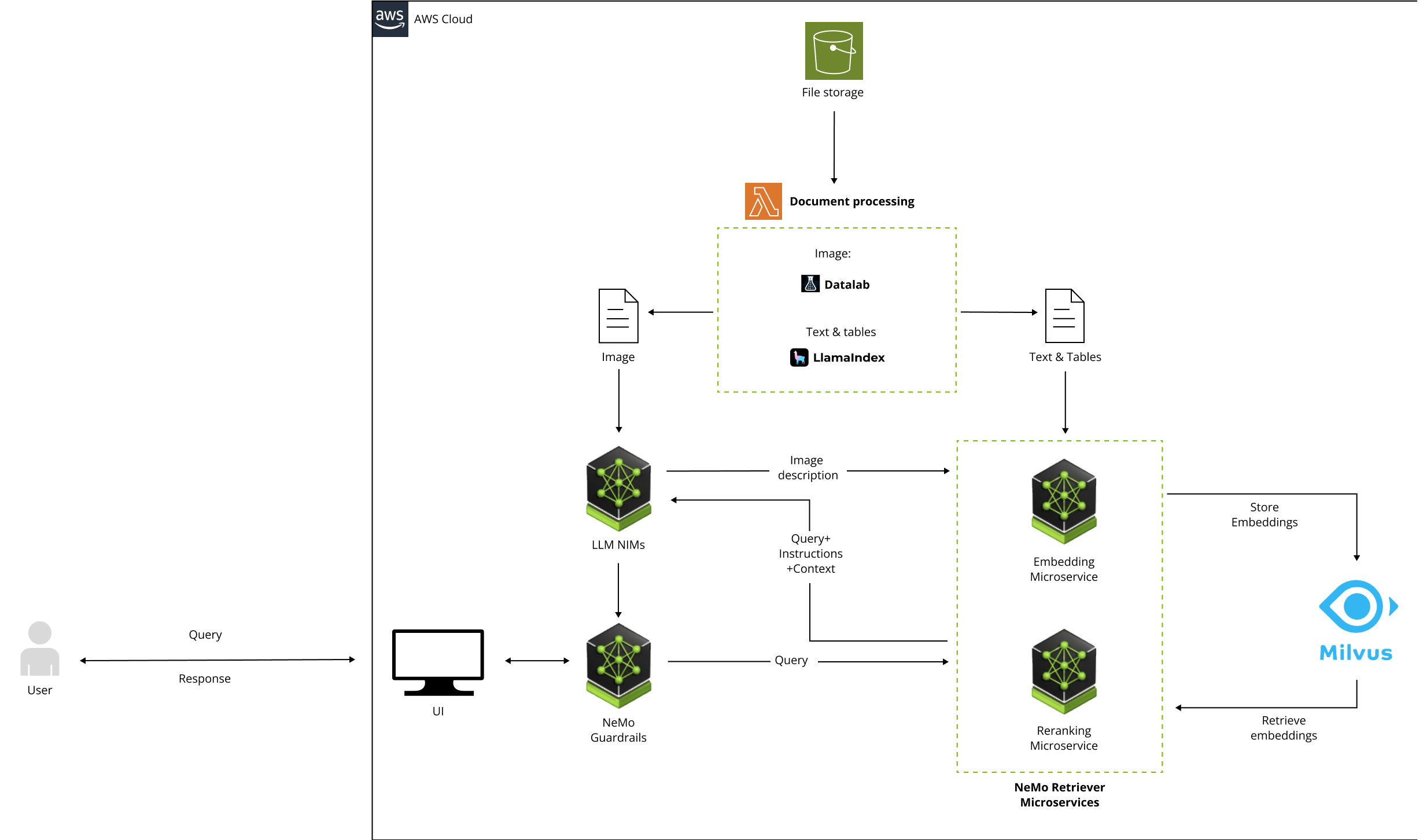

SoftServe Multimodal Rag System
Transform the way you handle document analysis and data processing with Generative AI. Accelerated by NVIDIA AI Blueprints, SoftServe Multimodal Retrieval-Augmented Generation (RAG) System accumulates data from multiple sources — text, images, and tables — to provide accurate and comprehensive responses. Whether in healthcare, finance, legal, manufacturing, or energy, you can easily interact with your data through an intuitive chatbot and gain valuable insights.
Multimodal RAG solution addresses this challenge with:
- Unified data processing: Combine images, text, and tables into a single view for thorough analysis.
- Enhanced data utilization: Attain more accurate responses by leveraging data from various modalities.
- Cross-modal understanding: Improve accuracy by considering the context from different data types.
- Cross-domain adaptability: Deploy across multiple industries like healthcare, finance, legal, manufacturing, and energy.
Multimodal rag aids in this transformation.
Multimodal Rag System Explained
SoftServe Multimodal RAG System allows swift access to information from different sources. It perceives the context from multiple data forms, offering more accurate and reliable responses. Additionally, the solution supports natural language interactions, enabling users to talk to the system.
NVIDIA AI Blueprints enable robust and scalable deployment of Generative AI workflows, allowing our Multimodal RAG System to manage large data volumes and deliver real-time insights across industrial environments. Enhanced processing capabilities and optimized tools shorten the time needed to develop, test, and deploy AI models, speeding up the development cycle and allowing the user to quickly benefit from new features.

- Improve operational efficiency
- Enhance decision-making
- Drive innovation within your organization
- Achieve more accurate data analysis
How It Works
Data Layer
Handles the entire data lifecycle — from curation and preparation to storage and analysis. This ensures high-quality, structured, and scalable data management with NVIDIA NeMo Curator, making it easier to extract actionable insights.
AI/ML Layer
Provides a robust ecosystem for developing, training, evaluating, deploying, and managing machine learning models. This layer automates complex tasks and speeds up the deployment of AI-driven solutions using NVIDIA NIM microservices and NVIDIA NeMo Framework.
Application Layer
Enables seamless interactions between people and applications with secure APIs, efficient data processing, and advanced conversational AI. This layer ensures a responsive and intelligent user experience through a voice interface powered by NVIDIA Riva and NVIDIA NeMo microservices.
Infrastructure Services
Support development and operations with continuous integration, deployment practices, and thorough logging and monitoring. This layer ensures the system is reliable and scalable and delivers software solutions quickly.
Solution Architecture
SoftServe Multimodal RAG architecture leverages NVIDIA components with other advanced technologies to deliver a comprehensive, scalable, and efficient solution for data-driven and AI-powered applications.
NVIDIA AI Enterprise Software Used
- NVIDIA NIM Llama-3.1*
- NVIDIA NIM NeVA-22b
- NVIDIA NeMo Retriever Embedding Microservice
- NVIDIA NeMo Retriever Reranking Microservice
- NVIDIA Riva

Use Cases
01Technical Document Analysis
02Medical Records Integration
03Financial Report Processing
04Legal Document Review
05Manufacturing Documentation Analysis

Our Implementation Cycle
01Assessment & Design
- Define use cases and challanges
- Analyze current data and systems
- Establish success criteria and constraints
- Develop use case workflows and user stories
- Evaluate data infrastructure and feasibility
- Draft initial solution design and project plan
02Pilot Phase
- Design Multimodal RAG architecture
- Set up infrastructure and supporting components
- Design and test UI/UX
- Integrate data sources and retrieval systems
- Develop prompt flows for selected use cases
- Launch trial version and collect data
03Product Rollout & Improvements
- Conduct focus group testing for trial version
- Onboard and train end users
- Analyze feedback and performance metrics
- Plan and implement iterative improvements
- Execute full-scale rollout
- Define use cases and challanges
- Analyze current data and systems
- Establish success criteria and constraints
- Develop use case workflows and user stories
- Evaluate data infrastructure and feasibility
- Draft initial solution design and project plan



